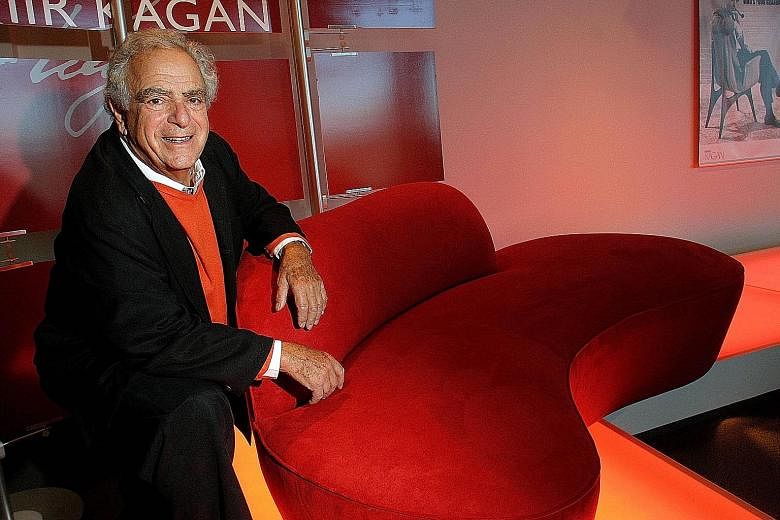NEW YORK • In hotelier Andre Balazs' office in Lower Manhattan, in front of his industrial-looking Charlotte Perriand desk, sits a Vladimir Kagan chair. Upholstered in green leather, it has been used for all the usual purposes, from making phone calls to firing off e-mail messages.
Yet Mr Balazs does not talk about it as if it were any chair.
He refers to its "sensuously curved legs" and how sitting in it is like "being enveloped by a nymph".
"Try not to make me sound dirty," he said. "But I think that with good furniture, if it doesn't at some point make you want to make love on it, it's missing something."
He is not alone in that response.
Whenever people talk about the work of Kagan, one of the 20th century's most successful designers, who died last Thursday aged 88, they almost invariably come around to the idea of sensuality.
His daughter Vanessa Diserio said he died of a heart attack in Palm Beach, Florida.
Everything about his swivels, swoops and exaggerated detailing is an invitation to experience his furniture tactility and enjoy it fully.
"A seductive curve" was how Ms Margaret Russell, editor-in- chief of Architectural Digest, described Kagan's design signature in an interview.
His reclining lounge chairs owe a clear debt to Scandinavian designers such as Finn Juhl and Hans Wegner.
Kagan's twist was to fuse their aesthetic with the biomorphic shapes of American designer Isamu Noguchi, stretching the wood legs out in the back almost like chewing gum, giving them a kooky Edward Scissorhands vibe.
His serpentine sofa, perhaps the best known of all Kagan's creations, is an armless, curvilinear swoosh of a thing (often upholstered in velvet) - what might be found if the Jetsons decided to relocate from Orbit City to the Trousdale Estates in Beverly Hills.
"I think he was wonderfully sexual," designer Tom Ford, a major client of Kagan's, said in an interview. "He gave off that kind of energy even in his later years."
Ms Wendy Goodman, design editor of New York magazine, said Kagan "understood that modernism does not have to be austere".
He was even selected to create furniture for the Monsanto House of the Future at Disneyland, a giant block of white fibreglass, which from 1957 to 1967 offered visitors a peek at what life might look like someday, complete with microwave ovens and floor-to-ceiling windows, the kind that have become a mainstay of contemporary architecture.
Kagan was not precious about the work he took on.
His father was a sculptor and cabinet-maker whose motto was "measure everything three times and cut once". Kagan liked to joke that he measured nothing and cut things over and over again.
Rather than being tortured by the creative process, he revelled in it, refusing over the course of many up, down, near-death experiences and tragic losses to be sidelined by almost anything.
He was born in Worms, a city in the Rhineland region of Germany, and grew up in a Jewish family. In 1937, his mother emigrated with him and his sister to France, then went to New York, where his father had already relocated.
He took classes in architecture at Columbia University and, without graduating, went to work at his father's cabinetry shop on 57th Street.
He eventually struck out on his own, designing glamorously exaggerated furniture and selling pieces to stars such as actresses Marilyn Monroe and Lily Pons and actor Gary Cooper. Today, actors Brad Pitt, Demi Moore, Uma Thurman and Tom Cruise are among the owners of Kagan pieces.
The Park Avenue apartment where Kagan lived with his late wife Erica Wilson - a needlepoint queen whose public-television show presaged the Martha Stewart era of do-it-yourself home improvement - was a wild, quirky monument to his career, complete with seemingly every major piece of furniture he ever put his stamp on.
The cardinal household rule, Ms Diserio said, was "do not jump on the furniture". Kagan is also survived by another daughter and a son.
NEW YORK TIMES

